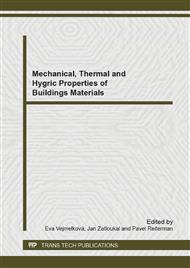p.104
p.108
p.114
p.119
p.125
p.130
p.136
p.141
p.145
Influence of High-Temperature on Polycarboxylate Superplasticizer in Aluminous Cement Based Fibre Composites
Abstract:
This paper summarizes the results of an experimental program aimed at investigating of the mechanical properties of composites based on aluminous cement for high-temperature applications and deal with the influence of high-thermal loading on polycarboxylate superplasticizing (PCSP) additive contained in the composite. The intent of this examination was caused by the suspicion that the action of high-temperatures can lead to burnout of the PCSP additive and thus subsequently affecting the mechanical properties of the final composite. Silica composites based on Portland cement and silica aggregates are not able to resist the effects of high-temperatures [1]. For high-temperature composites was therefore used aluminous cement Secar®71 (Lafarge S.A.) in combination with crushed basalt aggregates of fraction 0/4 and 2/5 mm. The flexural strength was greatly improved thanks combinations of basalt fibers with lengths of 6.35 mm and 12.7 mm. The values of flexural strength and compression strength were investigated on samples dried at temperature 105 °C or loaded for 180 minutes with high-temperature of 600 °C or 1 000 °C.
Info:
Periodical:
Pages:
125-129
Citation:
Online since:
July 2014
Authors:
Price:
Сopyright:
© 2014 Trans Tech Publications Ltd. All Rights Reserved
Share:
Citation:


